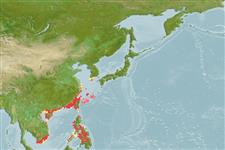Common names from other countries
Environment: milieu / climate zone / depth range / distribution range
Ecologia
marinhas associadas(os) a recifes; intervalo de profundidade 15 - 30 m (Ref. 90102). Tropical; 35°N - 8°N, 105°E - 128°E (Ref. 5222)
Western Pacific: southern Japan to Taiwan, China including Hainan, Hong Kong, Viet Nam, Philippines, and Sarawak, Malaysia.
Tamanho / Peso / Idade
Maturity: Lm ? range ? - ? cm
Max length : 30.0 cm TL macho/indeterminado; (Ref. 5222); common length : 20.0 cm TL macho/indeterminado; (Ref. 9137)
Espinhos dorsais (total) : 11; Raios dorsais (total) : 15 - 17; Espinhos anais: 3; Raios anais : 7 - 8. Distinguished by having grey brown color shading to whitish, yellowish or pink ventrally; head and body with numerous small yellowish brown, orange brown or brown spots; in juveniles and subadult, five slightly oblique brown bars on body that bifurcate ventrally; ctenoid body scales except cycloid anterodorsally above lateral line and on thorax and abdomen; body with auxiliary scales; greatest depth of body 2.8-3.3 in SL; rounded caudal fin; pelvic fins 1.9-2.3 in head length (Ref. 90102); further characterized by having a slightly convex interorbital area and dorsal head profile; angular preopercle, serrae at the angle slightly enlarged; straight upper edge of operculum; subequal posterior and anterior nostrils; maxilla reaching about below rear third of eye or a little past eye; 2-3 rows of subequal teeth on midlateral part of lower jaw (Ref. 89707).
Inhabits shallow rocky areas and feeds on small fishes, prawns, crabs, worms, and gastropods (Ref. 89707). An excellent food fish and brings a good price. Solitary, found in rocky bottoms in 15-30 m (Ref 90102).
Ciclo de vida ou comportamento de acasalamento
Maturities | Reprodução | Spawnings | Egg(s) | Fecundities | Larvas
Heemstra, P.C. and J.E. Randall, 1993. FAO Species Catalogue. Vol. 16. Groupers of the world (family Serranidae, subfamily Epinephelinae). An annotated and illustrated catalogue of the grouper, rockcod, hind, coral grouper and lyretail species known to date. Rome: FAO. FAO Fish. Synop. 125(16):382 p. (Ref. 5222)
Status na Lista Vermelha da UICN (Ref. 130435)
CITES (Ref. 128078)
Not Evaluated
Ameaça para os humanos
Harmless
Uso pelos humanos
Pescarias: espécies comerciais
Ferramentas
Relatórios especiais
Baixar XML
Fontes da internet
Estimates based on models
Preferred temperature (Ref.
115969): 21.9 - 28.4, mean 27.1 (based on 52 cells).
Índice de diversidade filogenética (Ref.
82804): PD
50 = 0.5000 [Uniqueness, from 0.5 = low to 2.0 = high].
Bayesian length-weight: a=0.01175 (0.00571 - 0.02419), b=3.04 (2.88 - 3.20), in cm Total Length, based on LWR estimates for this Genus-body shape (Ref.
93245).
Nível Trófico (Ref.
69278): 3.6 ±0.58 se; based on food items.
Resiliência (Ref.
120179): médio(a), tempo mínimo de duplicação da população 1,4 - 4,4 anos (Preliminary K or Fecundity.).
Fishing Vulnerability (Ref.
59153): Low vulnerability (20 of 100).
